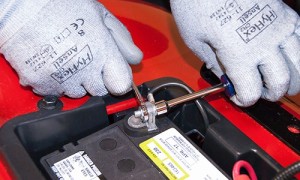How to replace the brake interlock switch on a riding lawn mower

This DIY riding mower repair guide gives step-by-step instructions for replacing the brake interlock switch on a riding lawn mower. When working correctly, this safety switch keeps the engine from starting if your foot isn’t pressing down on the brake or if the parking brake isn’t set. If the switch breaks, it won’t let current reach the starter solenoid coil even though the brake is on, and the engine won’t start. If the solenoid doesn't click when you turn the ignition key, the brake interlock switch is most likely at fault. Watch this lawn tractor troubleshooting video to learn how to test the starting system and brake interlock switch. Replace the brake interlock switch with a manufacturer-approved riding lawn mower part.
You can use the steps in this guide to replace a broken brake interlock switch on common Craftsman, MTD, Troybilt, Husqvarna, Cub Cadet, Snapper and Ariens lawn tractors and riding mowers.
Replacing a brake interlock switch on a riding lawn mower.
Instructions
- 01.
Disconnect the battery
Park the tractor on a level surface, but don't set the parking brake so that you'll be able to remove the brake interlock switch.
Turn the ignition switch off and remove the key.
Wear work gloves to protect your hands.
Lift the seat.
Remove the bolt connecting the negative cable to the battery and tuck the cable away from the battery so it doesn't touch the battery post.

PHOTO: Disconnect the battery.
- 02.
Release the steering plate
Lower the mower deck to its lowest position.
Remove the left rear steering plate mounting bolt.
Remove the left front steering plate mounting bolt and the upstop bracket.

PHOTO: Remove the upstop bracket.
- 03.
Remove the brake interlock switch
Lift the hood.
Remove the lower dash fastener and pull off the lower dash.
Remove the wire harness from the brake interlock switch.
Squeeze the brake interlock switch mounting tabs and push the switch down to release the switch from the tractor frame.
Push straight down on the brake pedal to lower the steering plate and remove the brake interlock switch.
Tip: Remove the fuel tank and rest it on top of the engine if you need more room.
PHOTO: Remove the brake interlock switch.
- 04.
Install the new brake interlock switch
Position the new brake interlock switch under the tractor frame.
Push straight down on the brake pedal to lower the steering plate and snap the new brake interlock switch onto the tractor frame.
Connect the wire harness to the new brake interlock switch.
Reinstall the lower dash and secure it with the fastener.
Lower the hood.

PHOTO: Connect the brake interlock switch wire.
- 05.
Reinstall the steering plate
Position the upstop bracket on the frame and reinstall the left front mounting bolt in the steering plate.
Reinstall the left rear mounting bolt in the steering plate.

PHOTO: Reinstall the upstop bracket.
- 06.
Reconnect the battery
Set the parking brake.
Reconnect the negative cable to the negative battery terminal.
Lower the seat.
Most common symptoms to help you fix your riding mowers & tractors
Choose a symptom to see related riding mower and lawn tractor repairs.
Main causes: faulty battery, bad alternator…
Main causes: damaged cutting blade, worn deck pulley, damaged mandrel pulley, loose fasteners on mower deck components…
Main causes: damaged tie rods, bent or worn wheel spindle, worn front axle, damaged sector gear assembly…
Main causes: worn or broken blade belt, broken belt idler pulley, blade clutch cable failure, bad PTO switch, damaged ma…
Main causes: punctured tire or inner tube, leaky valve stem, damaged wheel rim…
Main causes: engine overfilled with oil, leaky head gasket or sump gasket, damaged carburetor seals, cracked fuel pump, …
Main causes: clogged carburetor, damaged flywheel key, dirty spark plug, stale fuel, improper valve lash, engine needs a…
Main causes: shift lever needs adjustment, neutral control needs adjustment…
Main causes: worn or broken ground drive belt, bad seat switch, transaxle freewheel control engaged, transaxle failure, …
Most common repair guides to help fix your riding mowers & tractors
These step-by-step repair guides will help you safely fix what’s broken on your riding mower or lawn tractor.

How to replace the starter motor on a riding lawn mower
If you hear the solenoid click but don’t hear the starter motor spin when you turn the key, follow these steps to replac…

How to rebuild a riding lawn mower carburetor
Get your sputtering carburetor running smoothly in 60 minutes.…

How to replace a riding lawn mower rear tire
Your mower can’t run on a damaged rear tire. Here’s how to install a new one.…
Effective articles & videos to help repair your riding mowers & tractors
Use the advice and tips in these articles and videos to get the most out of your riding mower or lawn tractor.

Learn about all the convenient features on our Sears PartsDirect website that make your parts purchases easier.…

Get answers to frequently asked questions about Sears and Sears PartsDirect.…

Check the starter solenoid, starter motor, wiring, battery and engine.…